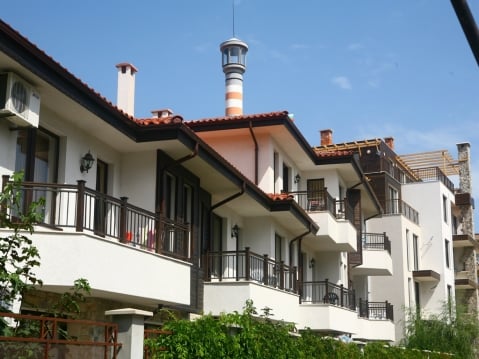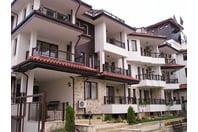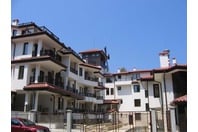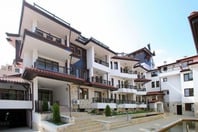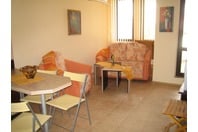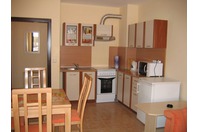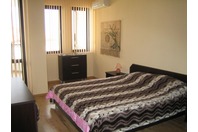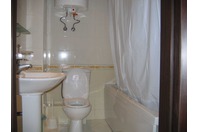1-bed Property for sale at Sozopol Dreams Bulgaria
Appreciating Assets are delighted to offer for sale this large 57 sq.m fully-furnished 2nd floor 1-bedroomed apartment in Sozopol Dreams for the great price of only 45,000 euros.
Property Description
This property is extremely spacious with 57 square metres of internal floorspace, especially as it is a 1-bedroomed plus 1-bathroom apartment. Located on the second floor of the building, the property enjoys sea views from the balcony .It is in a gated holiday complex, with controlled access, 24-hour security and a year-round maintenance. It is only 50 metres away from the seashore and the picturesque ‘Harmanite’ beach. The apartment is in excellent condition and is fully-furnished. In addition to the main bedroom, there is a living room with a dining-corner and a kitchenette, a bathroom with a bath tub and a separate terrace. The fully-equipped kitchen includes a fridge, hot-plates, a microwave oven, an aspirator, as well as food-preparation facilities.Theh apartment is air-conditioned and has its own boiler, a bath tub in the bathroom and all conveniences.
Apartment Facilities Summary:
- air-conditioning
- balcony
- bath/WC
- cable/ satellite TV
- daily maid service (optional)
- direct dial telephone
- hairdryer
- Internet access
- paid TV (optional)
- shower
Sozopol Dreams
Location: The Sozopol Dreams complex is situated in one of the most romantic and artistic towns in Bulgaria – Sozopol. The building is designed in the old Sozopol house style and reveals a breath taking view to the Black Sea and the beaches of fine golden sand. The windmill, the old lighthouse and the fish boats as elements add charm and impart an air of cosiness to the complex. The romantic atmosphere is reinforced by the glass mirror in the inner yard and the places for relaxation.
Sozopol dreams complex is situated in the immediate vicinity of the new part of Sozopol. The town of Burgas and Burgas airport are only 30km away from the complex.
Sozopol - The History
Sozopol is the oldest town on the Bulgarian Black Sea coast. The first settlement at these places dates back to IV - III B.C. The undersea explorations in the region of the port reveal relics of dwellings, ceramic pottery, stone and bone tools from the bronze era.
In the Sozopol bay many anchors from II – I B.C .have been discovered, proof of active shipping since ancient times.
The town established itself as a trade and naval centre. It kept strong political and trade relations with the great cities of Elada – Milet, Athina, Corinth, Heraklea Pontica and the islands – Rhodos, Xios, Lesbos, etc. Its trade influence in the Thracian territories was based on a treaty with the rulers of the Odrissian kingdom back at the V century B.C.
The symbol of the town – the anchor, present on all coins, minted by Apolonia since VI century B.C. is proof of the importance of the trade. The rich town soon became an important cultural centre. At these times it was called Apolonia Magna (Great).
The ancient icons and magnificent woodcarving iconostases are a remarkable accomplishment of the craftsmanship of these times. The architecture of the houses in the old town from the renaissance period makes it a unique place to visit today.
Sozòpol (Bulgarian: Созопол, Greek: Sozopolis / Σωζόπολις) is an ancient seaside town located 35 km south of Burgas on the southern Bulgarian Black Sea Coast. Today it is one of the major seaside resorts in the country, known for the Apollonia art and film festival (which takes place in early September) that is named after one of the town's ancient names.
The busiest times of the year are the summer months, ranging from May to September as tourists from around the world come to enjoy the weather, sandy beaches, history and culture, fusion cuisine (Balkan, Mediterranean), and atmosphere of the colourful resort.
Sozopol is one of the oldest towns on Bulgarian Thrace's Black Sea coast. The first settlement on the site dates back to the Bronze Age. Undersea explorations in the region of the port reveal relics of dwellings, ceramic pottery, stone and bone tools from that era. Many anchors from the second and first millennium BC have been discovered in the town's bay, a proof of active shipping since ancient times.
The current town was founded in the 7th century BC by Greek colonists from Miletus as Antheia. The name was soon changed to Apollonia, on account of a temple dedicated to Apollo in the town, containing a famous colossal statue of the god Apollo by Calamis, 30 cubits high, transported later to Rome by Lucullus and placed in the Capitol.
The coins, which begin in the fourth century BC, bear the name Apollonia and the image of Apollo; the imperial coins, which continue to the first half of the third century AD, and the Tabula Peutinger also contain the name Apollonia; but the "Periplus Ponti Euxini", 85, and the Notitiæ episcopatuum have only the new name Sozopolis. In 1328 Cantacuzene (ed. Bonn, I, 326) speaks of it as a large and populous town. The islet on which it stood is now connected with the mainland by a narrow tongue of land. Its inhabitants, in the past mostly Greeks, lived by fishing and agriculture.
The town established itself as a trade and naval centre in the following centuries. It kept strong political and trade relations with the cities of Ancient Greece – Miletus, Athens, Corinth, Heraclea Pontica and the islands Rhodes, Chios, Lesbos, etc. Its trade influence in the Thracian territories was based on a treaty with the rulers of the Odrysian kingdom dating from the fifth century BC.
The symbol of the town – the anchor, present on all coins minted by Apollonia since the sixth century BC, is proof of the importance of its maritime trade. The rich town soon became an important cultural centre. At these times it was called Apollonia Magna.
Ruled in turn by the Byzantine, Bulgarian and Ottoman Empires, Sozopol was assigned to the newly independent Bulgaria in the 19th century. At the outbreak of the Greek War of Independence (1821) prominent local personalities were arrested and executed by the Ottoman authorities due to participation in the preparations of the struggle.
Almost all of its Greek population was exchanged with Bulgarians from Eastern Thrace in the aftermath of the Balkan Wars. In 2011 the remainings of an ancient Greek settlement, part of Apollonia, were excavated in the small island of St. Kirik (Saint Cerycus) off Sozopolis.
Since 1984 Sozopol hosts the Apollonia art festivities every September, which include theatre shows, exhibitions, movies, musical and dance performances, book presentations and other cultural events.



